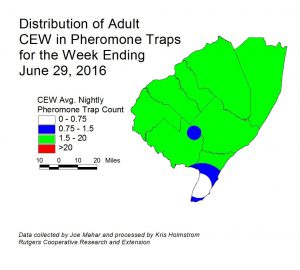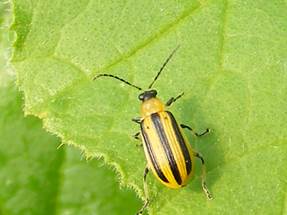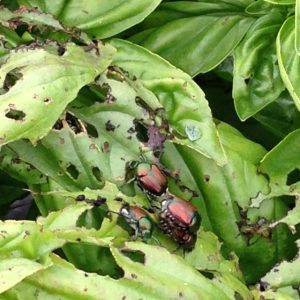Sweet Corn
European corn borer (ECB) moth catches remain very low now. The first flight is over, and growers are now managing subsequent infestations, which are generally lower than normal. Present adult activity is too low to generate a map image (<0.5 moths/night in all traps). Larval feeding ranges from single digits to above 20% in areas where IPM personnel are operating, although many plantings still have no detectable feeding at all. Be sure to begin monitoring plantings for ECB feeding while they are still in the whorl stage. Consider treating when the number of infested plants in a 50 plant sample exceeds 12%. Feeding in the whorl stage will appear as numerous small holes (called “shot-hole”) on leaves, with damage present on consecutively younger leaves. As plants progress to pre-tassel and beyond, droppings and larvae may be found in or on the emerging tassels. Any planting remaining at or above threshold as it proceeds to full tassel should be treated, as this is the last stage at which ECB larvae will be exposed and vulnerable to insecticidal sprays. Insecticides that are acceptable in organic production include the spinosyn based material Entrust (IRAC-5) and Dipel (IRAC-11a). The 10G formulation of Dipel is particularly useful when granules can be dropped or broadcast such that they get into the whorls of corn plants. Other effective insecticides include Coragen (IRAC 28), and the synthetic pyrethroids (IRAC 3). See the 2016 Commercial Vegetable Recommendations Guide for a more complete list of insecticides.
The highest nightly ECB catches for the previous week are as follows:
| Denville 1 | Matawan 1 |
| Farmingdale 1 | New Egypt 1 |
| Lawrenceville 1 | Old Bridge 1 |
| Little York 1 | Pennington 1 |
In addition, several low-level infestations of fall armyworm (FAW) were discovered this week. These were in Hunterdon and Middlesex counties, but it is likely that there are other light infestations throughout the state. These infestations have not exceeded 4% in the whorl stage, and are likely the result of a few FAW moths arriving in advance of weather fronts. This is somewhat early for FAW infestations in NJ, and we would expect to see little injury until mid-July. FAW feeding is much more obvious than that of ECB larvae, with large ragged holes and conspicuous droppings found in the whorl. FAW is resistant to synthetic pyrethroid insecticides (IRAC 3), and can be effectively managed with insecticides such as Radiant/Entrust/Blackhawk (IRAC 5) or Coragen/Besiege (IRAC 28). Consider treating if damage from ECB and/or FAW reaches 12%.
Corn earworm moth (CEW) captures in blacklights continue to be very low this past week. Present adult activity recorded in blacklights remains along the Delaware Bayshore although numbers were too low to generate a map image.
The highest nightly CEW catches for the previous week are as follows:
| Beckett 1 |
| Jones Island 1 |
In addition, a limited number of CEW pheromone traps have been deployed throughout the southern counties. These traps captured increased numbers of CEW moths late last week, but numbers have subsided over the weekend (see CEW pheromone map). The broad color patterns of this map are a result of the few numbers of contributing trap sites. Green areas on the map roughly correspond to a 4-5 day silk spray schedule. As sweet corn plantings begin to silk, it is critical that growers monitor local CEW moth numbers. For the present time, any sweet corn plantings in the silk stage should be treated to limit CEW injury as well as to prevent ear damage from ECB larvae that already inhabit the stalks.
The highest nightly CEW pheromone trap catches for the previous week are as follows:
| Pedricktown 8 | Woodstown 2 |
| Beckett 7 | East Vineland 1 |
For silking sweet corn, the following spray schedules are warranted.
Silking Spray Schedules*:
South – 4-5 days
Central – 6 days
North – 6-7 days
*These recommendations are based on regional catches.
Pepper Weevil Report
One weevil was caught in a field in the Hammonton area. The field has been treated. So far it does not appear that the field has an established infestation. No weevils were caught in traps at or near processing facilities.
Brown Marmorated Stinkbug (BMSB)
Very few BMSB have been captured in NJ blacklight traps this week. Numbers are still quite low. As this pest increases, maps will appear in this newsletter.
The highest nightly BMSB trap catches for the previous week are as follows:
| Allentown 1 | Crosswicks 1 | Green Creek 1 | New Egypt 1 |
| Beckett 1 | Eldora 1 | Hillsborough 1 | Pedricktown 1 |
| Cinnaminson 1 | Georgetown 1 | Matawan 1 | Princeton 1 |
These crops are now emerging in many areas. It is important to monitor frequently for the presence of striped cucumber beetles (see photo at right) at this time, particularly if the seed was not purchased pre-treated with an insecticide for cucumber beetle. Check 5 consecutive plants each in 10 random locations. Examine upper and lower surface of seed leaves for the presence of beetles. Consider treating if beetles are found at 5 or more sites. Heavy, but local infestations may be spot treated. Management of these pests will limit the loss of plants to the bacterial wilt disease that the beetles transmit.
A sentinel plot containing susceptible and resistant cucumber varieties, as well as muskmelons, watermelons, acorn and butternut squash and pumpkins is now established at the Snyder Research and Extension Farm in Hunterdon County. The purpose of this plot is to detect the presence of downy mildew (DM) in northern NJ. Any occurrence will be reported in this newsletter and will also generate an alert to all subscribers. For more information on the regional presence of DM as well as comprehensive, weekly forecasts, see the following website: http://cdm.ipmpipe.org/
Allium Leaf Miner
A sample from Hunterdon County that was submitted to USDA for identification in May has returned a positive result. This is the first incidence of allium leaf miner in New Jersey. All growers of onions and related crops should familiarize themselves with the symptoms of leaf miner infestations on these plants. Information and photographs may be found at the following site: http://www.agriculture.pa.gov/Protect/PlantIndustry/Pages/ALLIUM-LEAFMINER.aspx#.VyCuc6PD-Ik
Sweet Basil
Japanese beetles (see photo below) have been emerging from the soil and will begin feeding on basil soon if not already doing so. It is critical that sweet basil plantings be scouted several times a week, as this pest can rapidly defoliate the plants.




